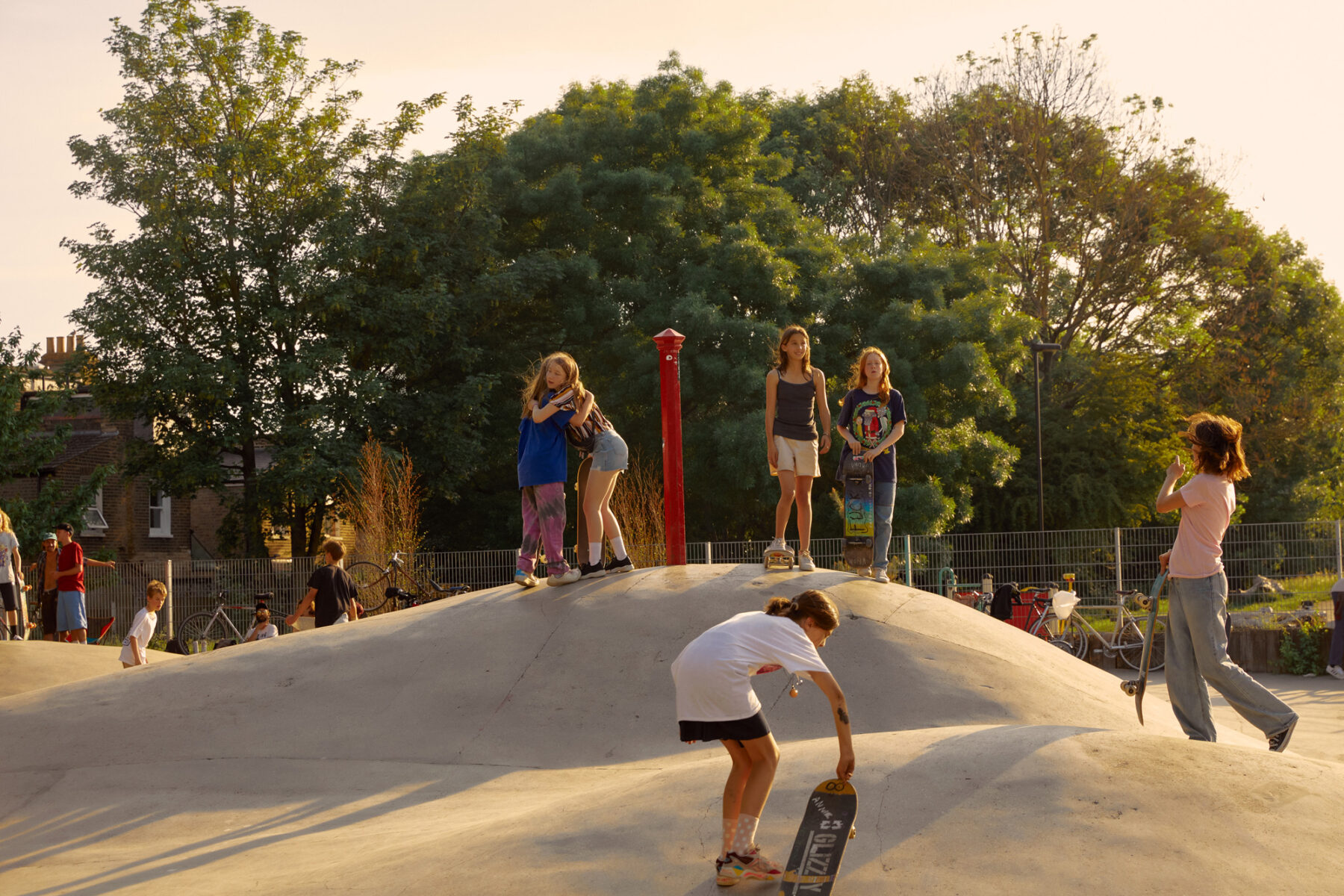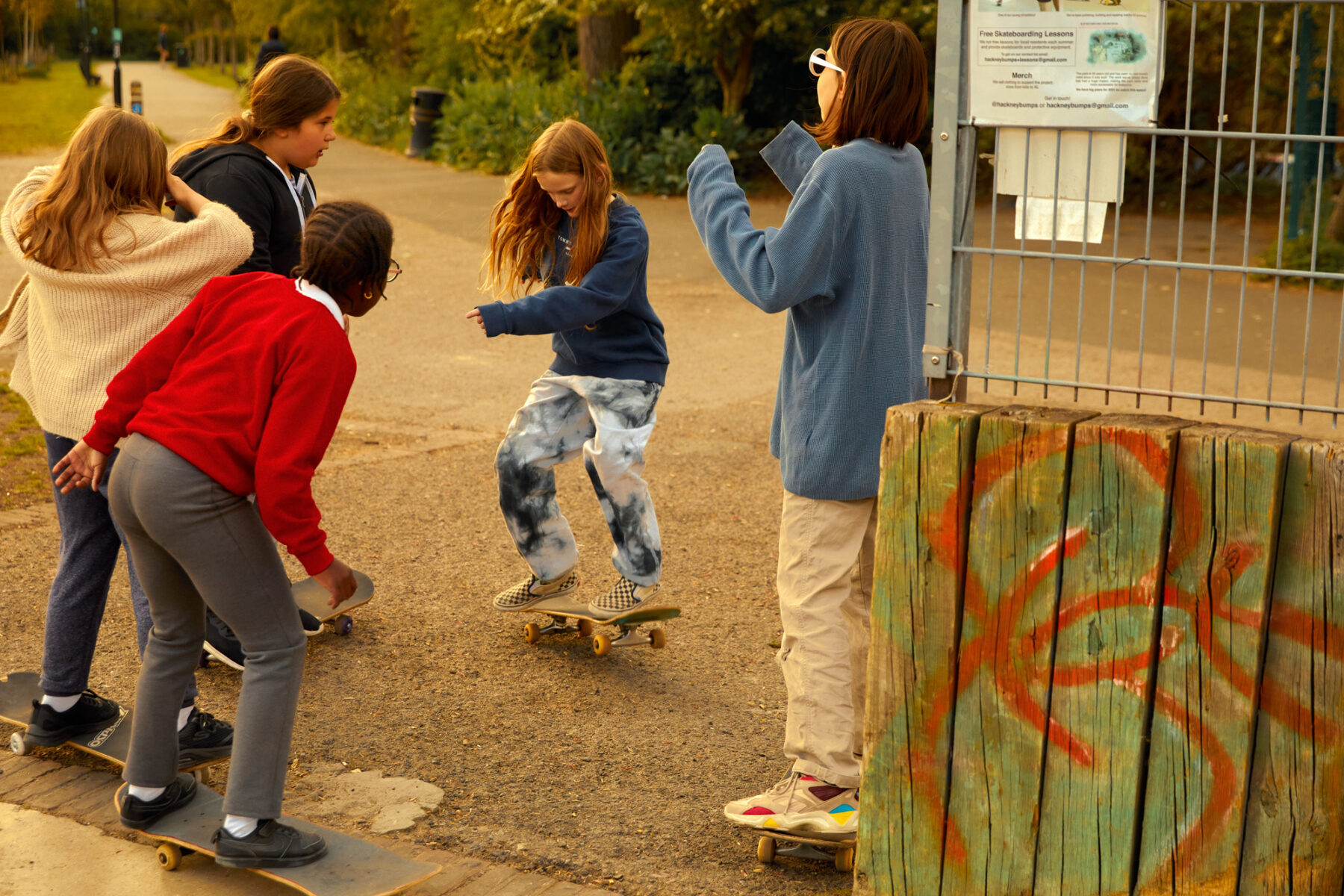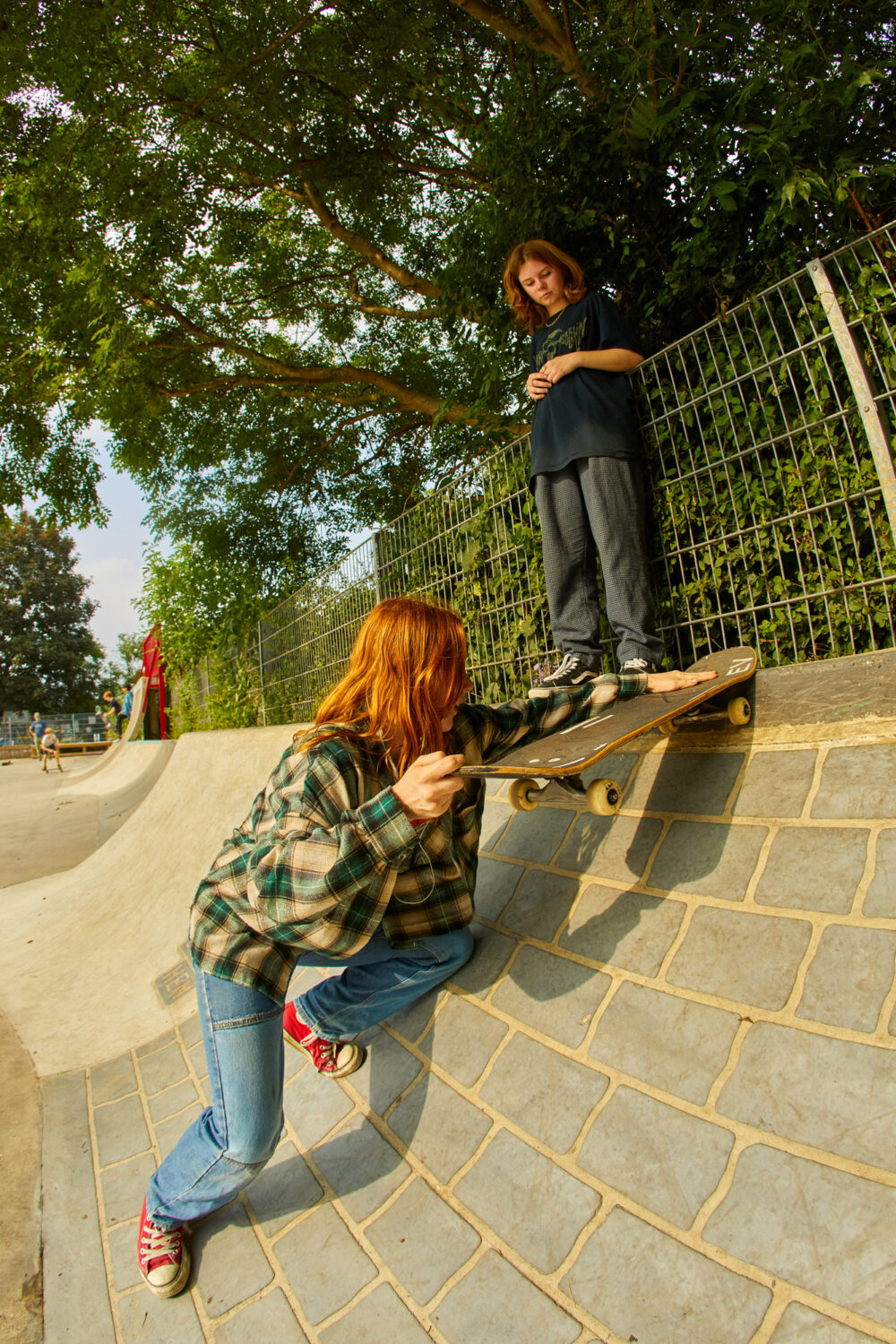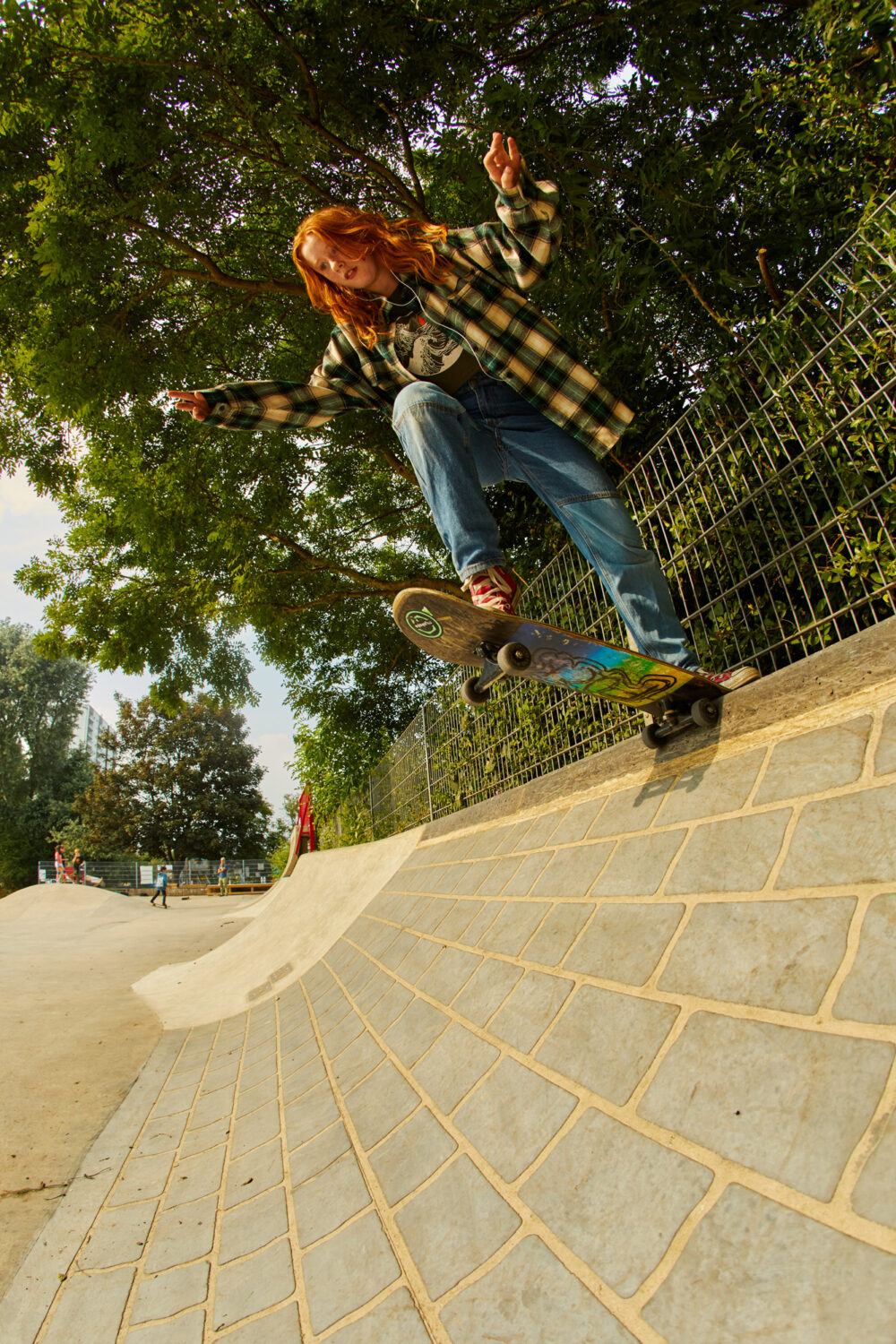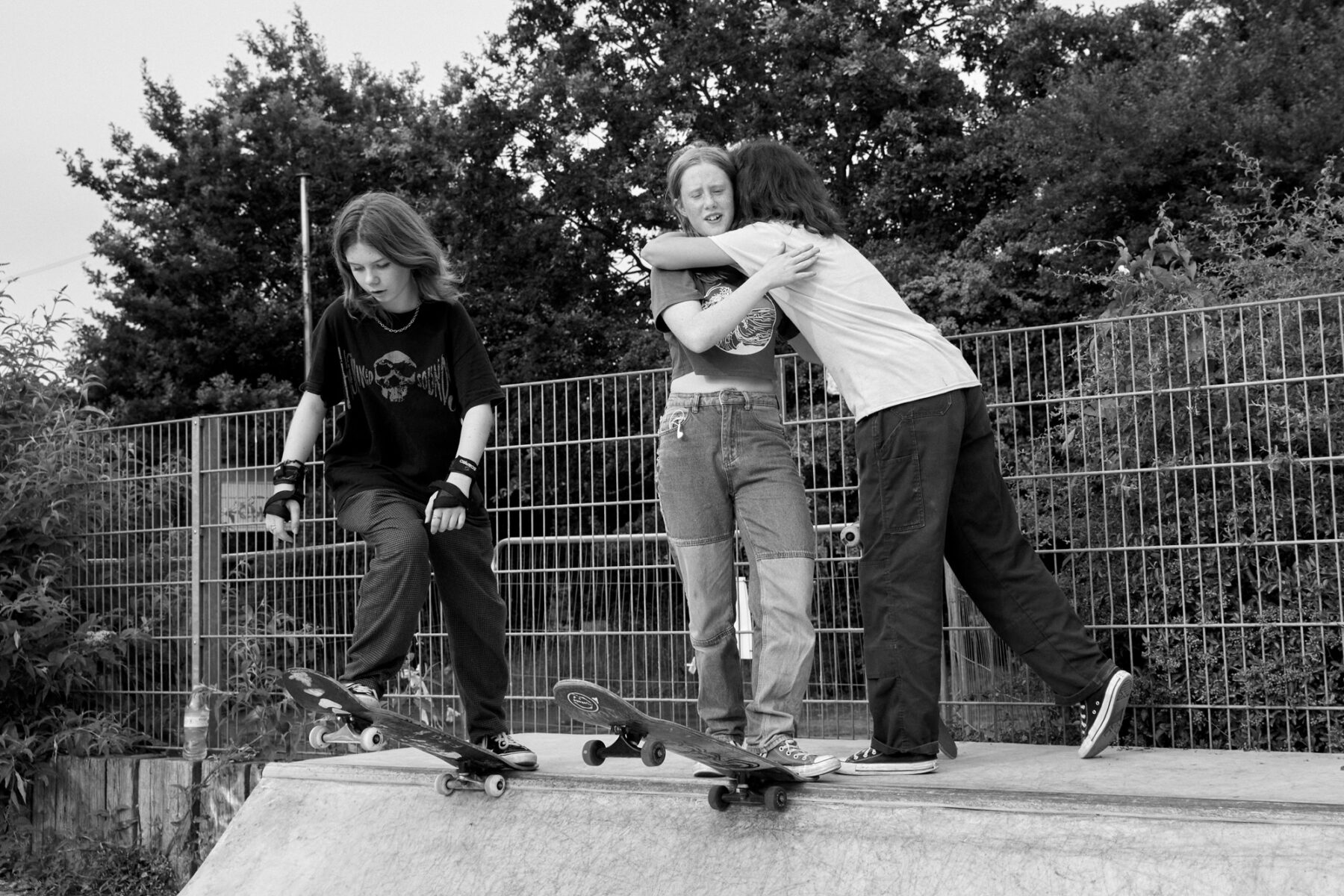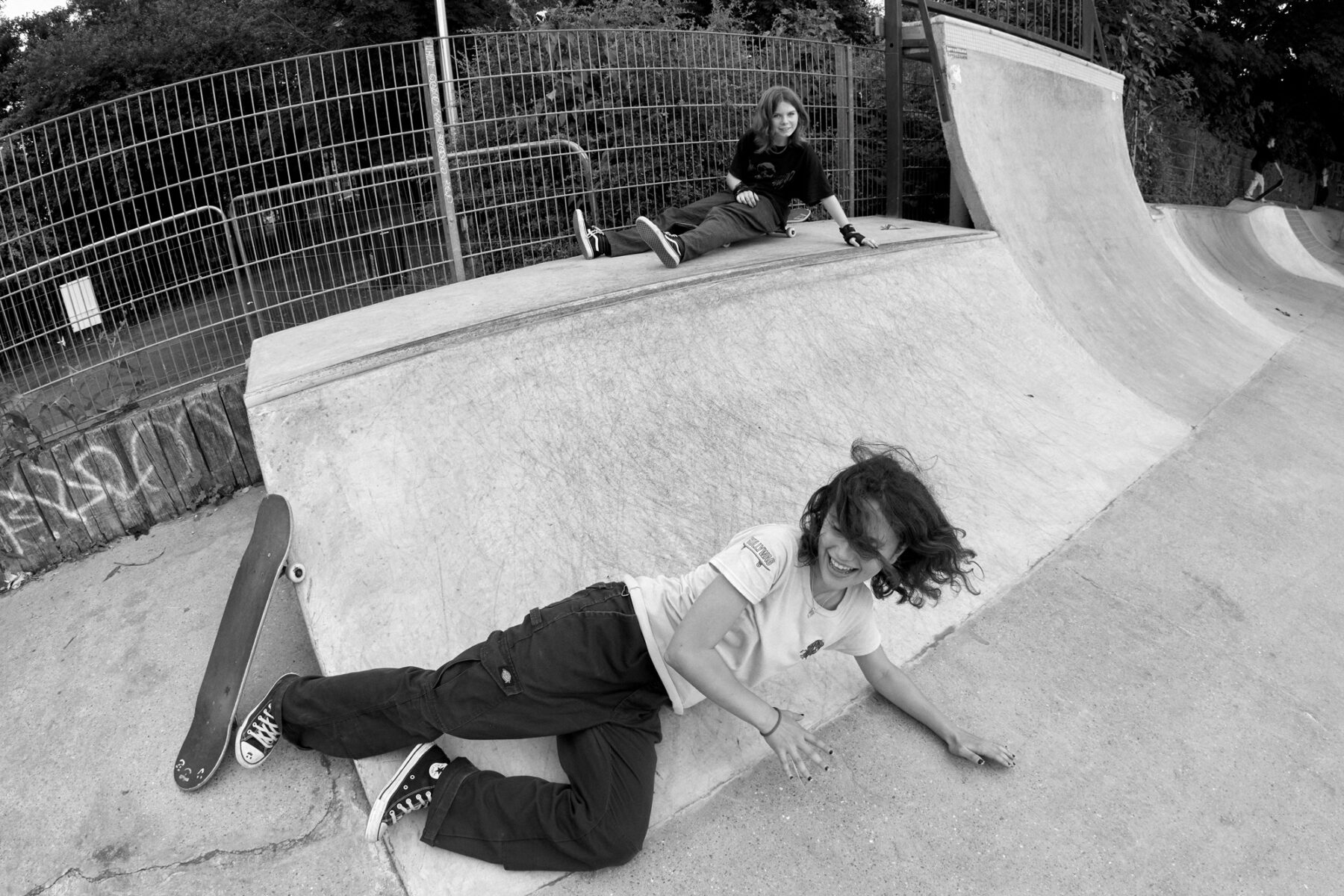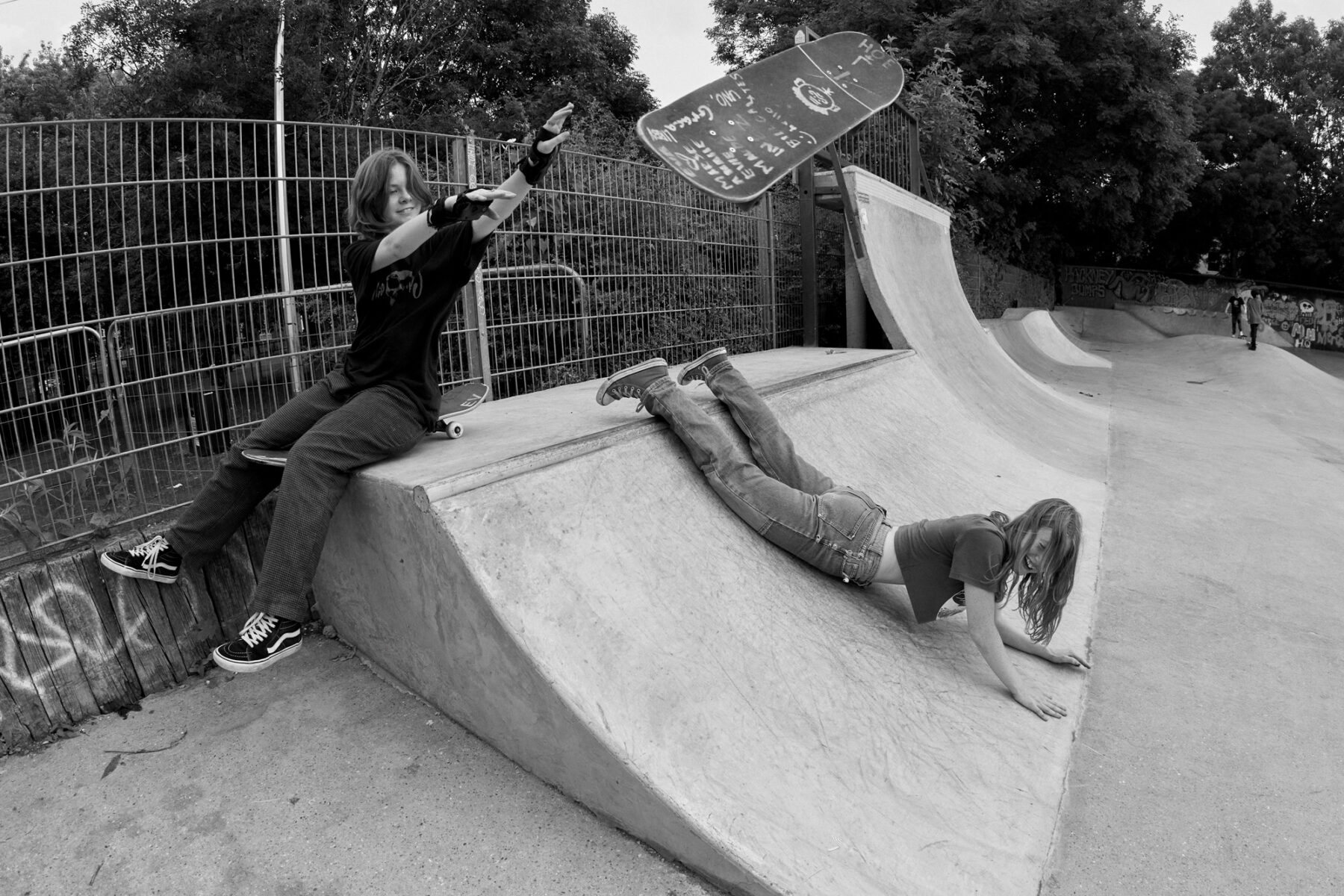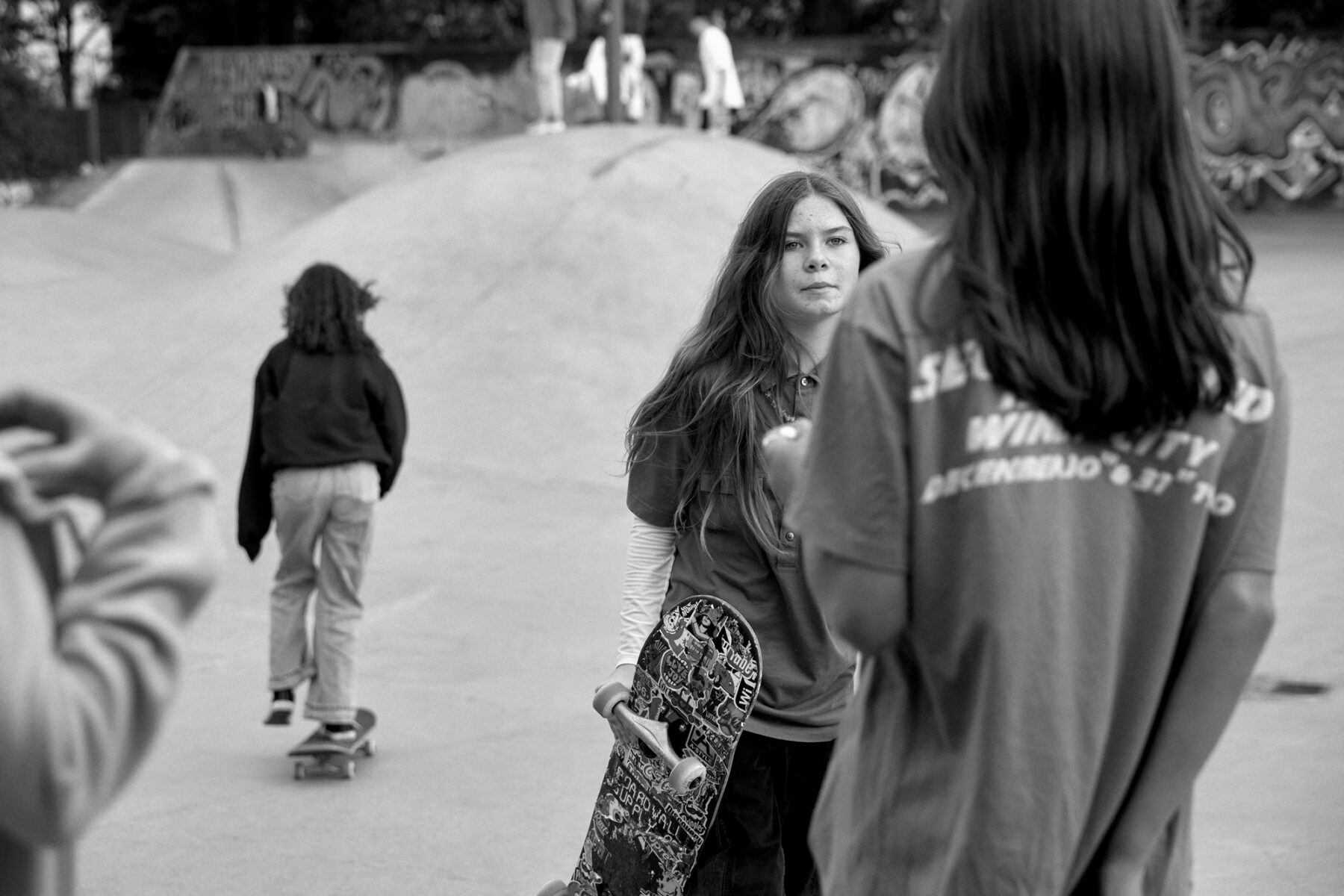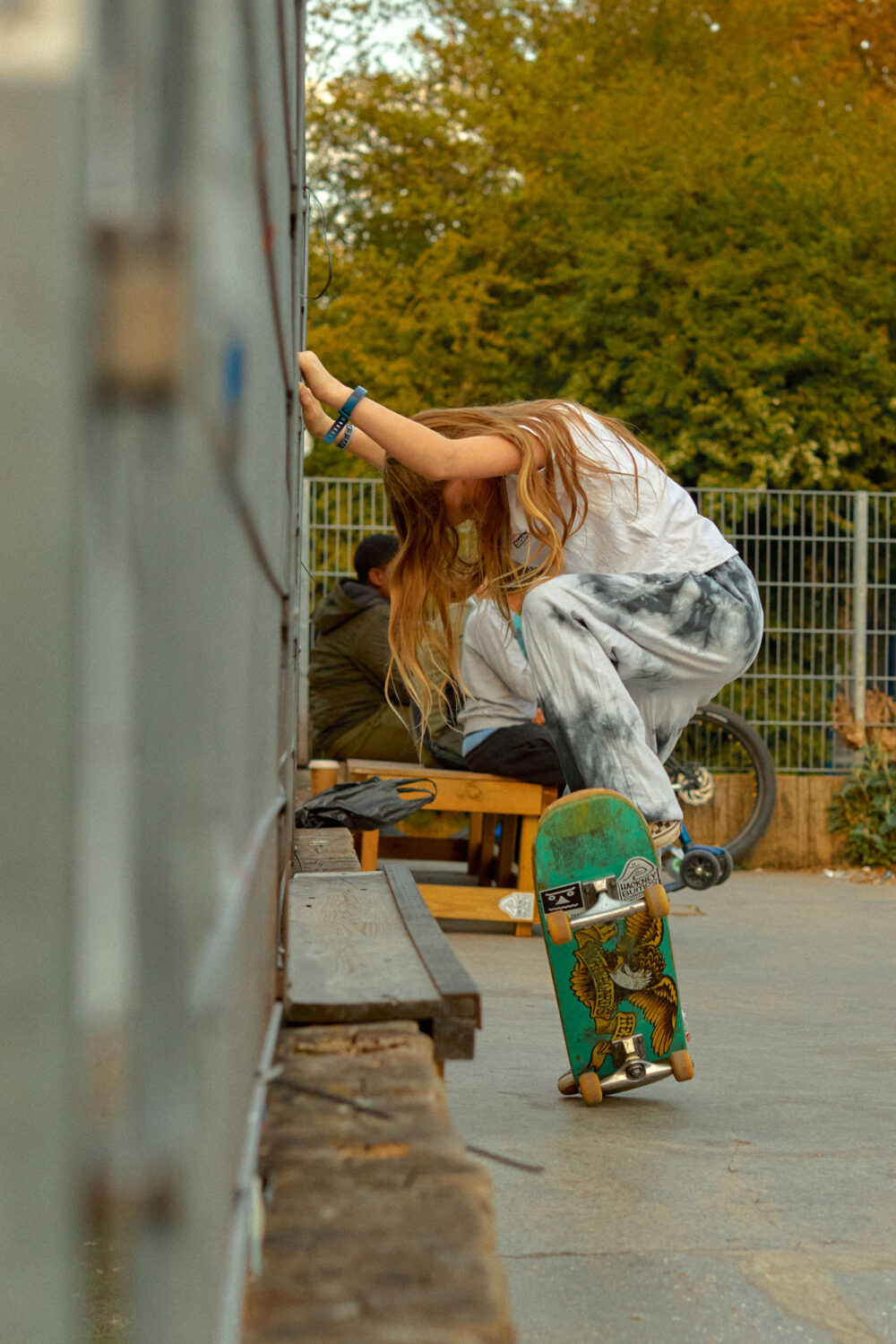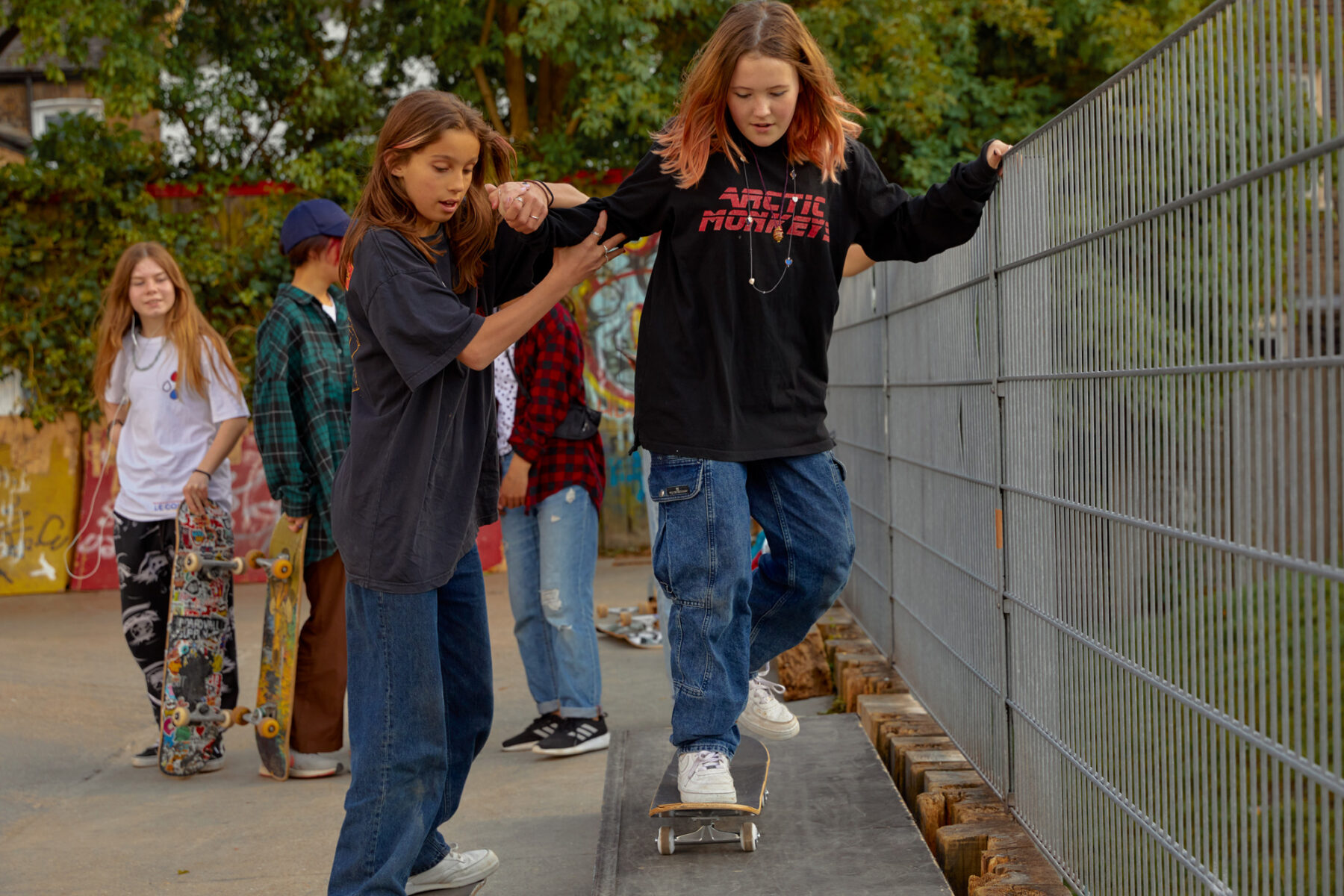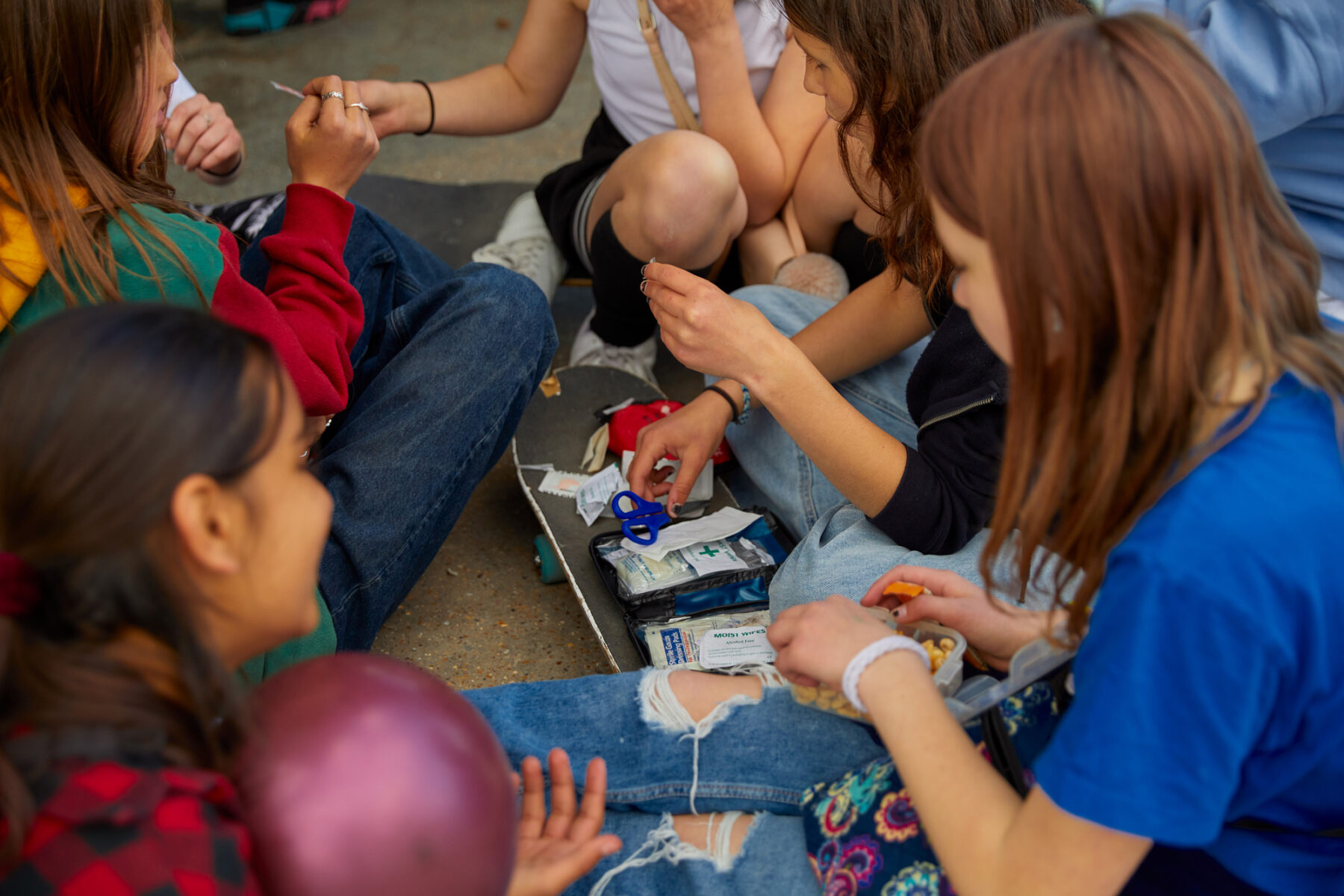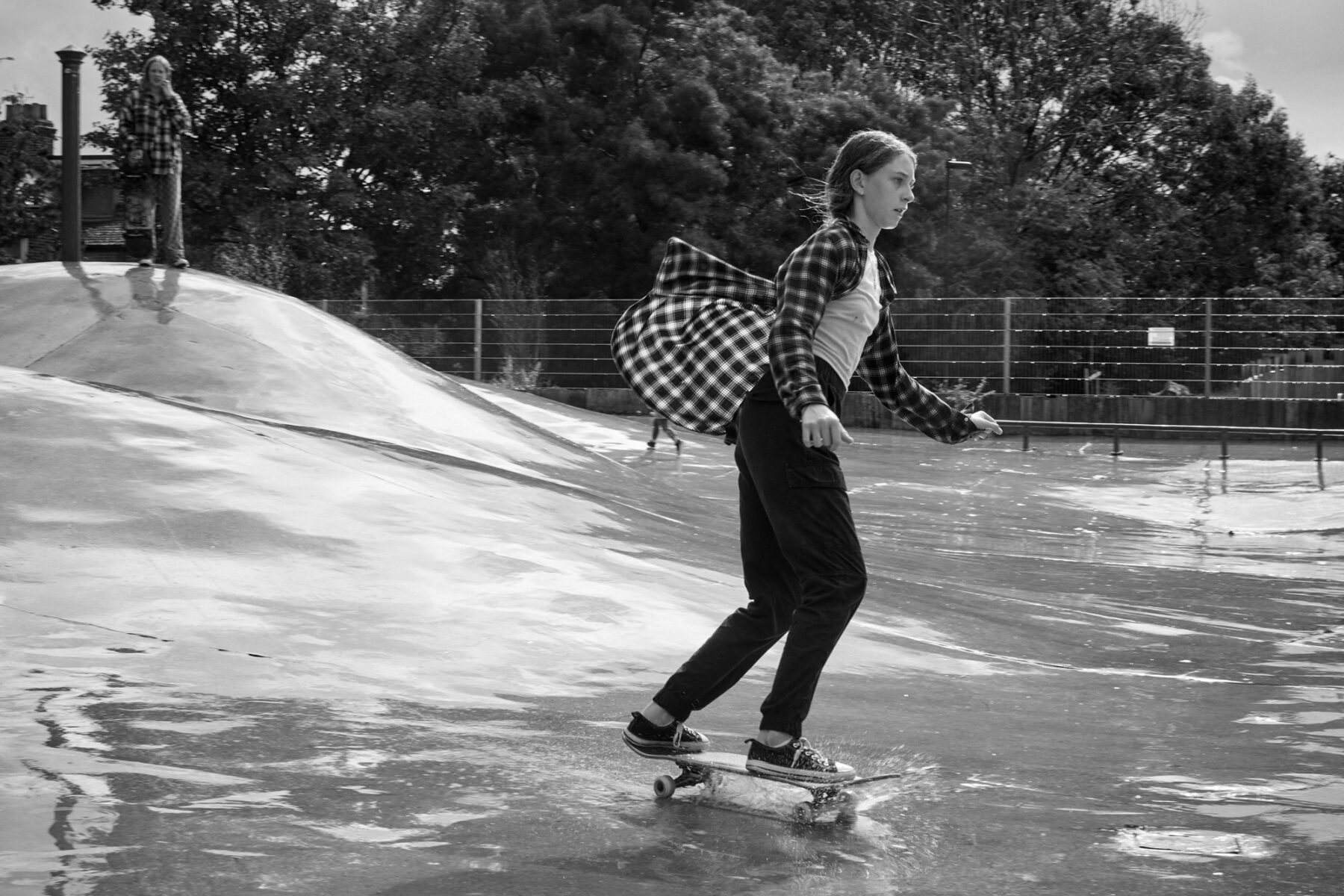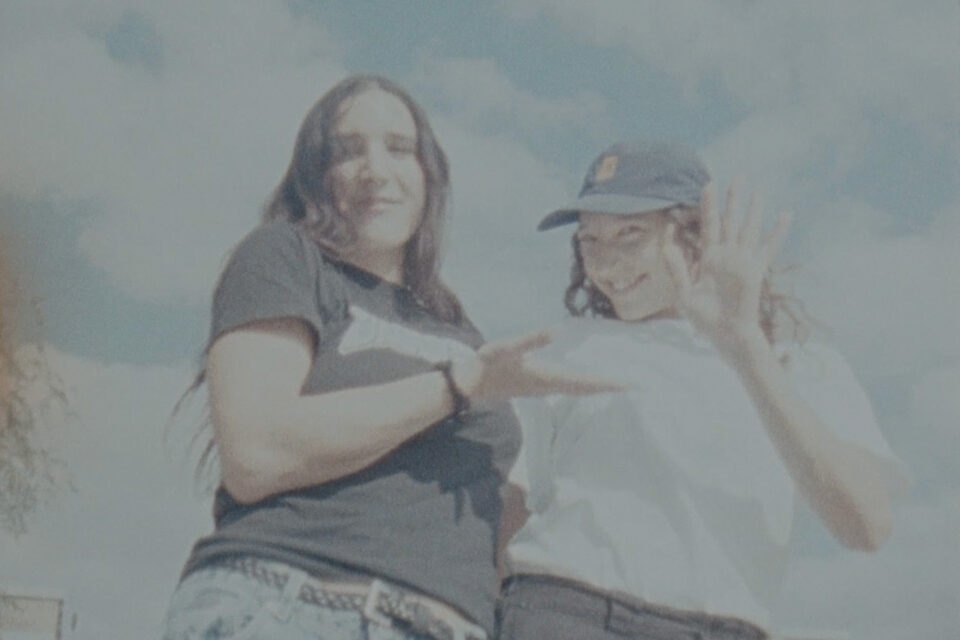Previous post
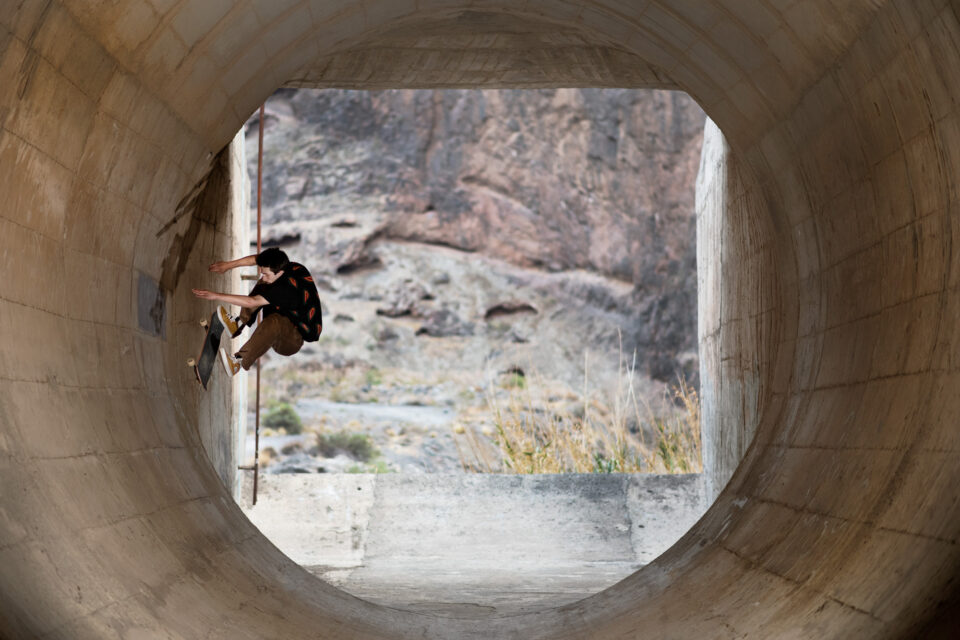
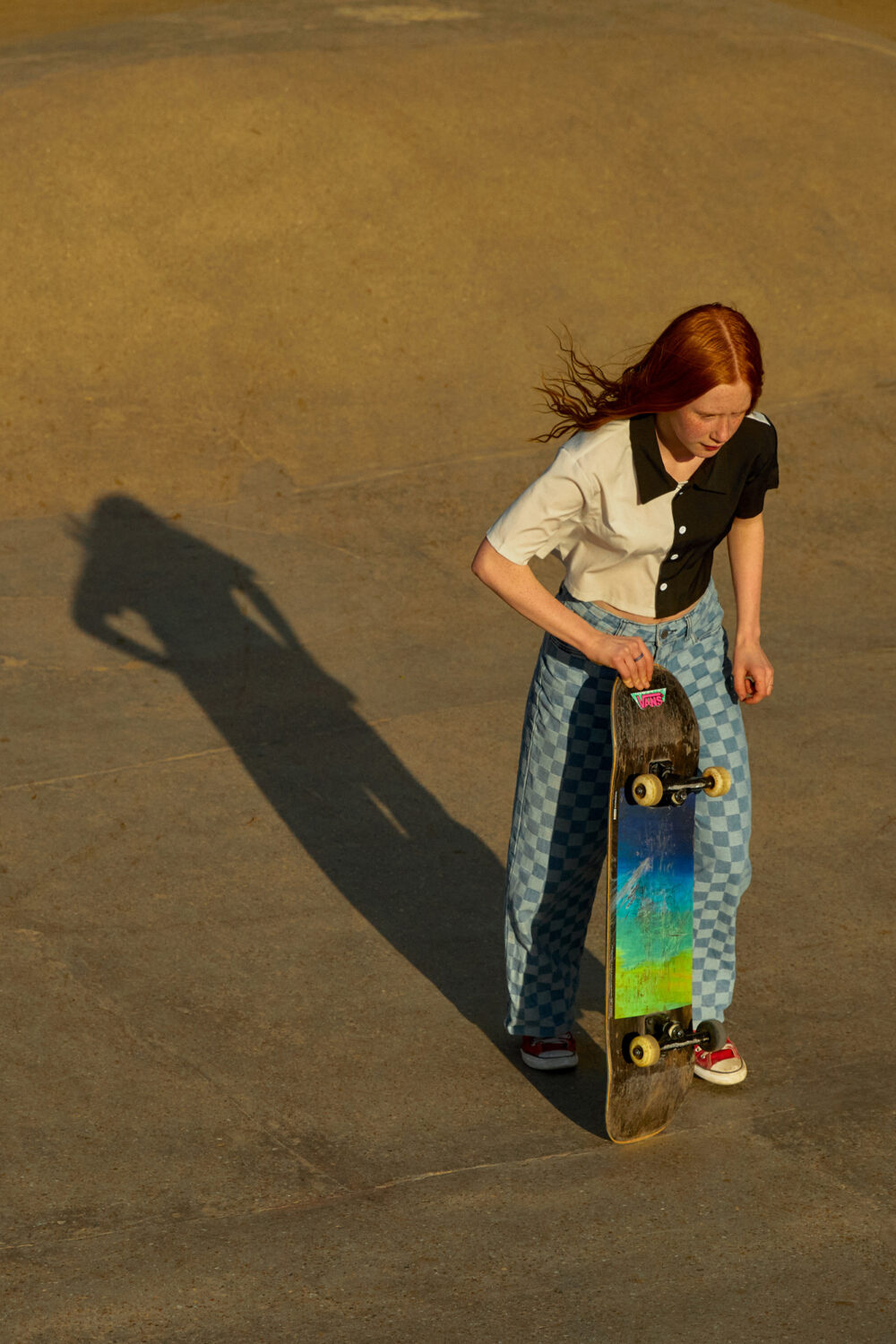
Words: Esther Sayers
Photography: Amanda Fordyce
Hard graft, occasional successes and friendship
The scene at many skateparks nationally has seen women and girls taking up skateboarding alongside men and boys in ever increasing numbers. They are forming an alternative girlhood1, consciously positioning themselves against what they perceive as the mainstream and against conventional forms of femininity in which bruises, scabs and scars would be unwelcome.
The term ‘girl skate’ is used here in its most expansive sense to also include trans and non-binary definitions of gender2. As Danni Gallacher, who created Girl Skate UK, said: “The trans community face the same kind of barriers in taking up skateboarding as the girl skate community have. I just feel like we should make it easier for everybody to access this amazing sport that we’ve got. Why gatekeep this?”
Skateparks are public and have been predominantly occupied by young men rather than young women. Consequently, a girl’s presence there can test the ownership of this public space, questioning: who has a right to be here? By skating in public parks girls antagonise the accepted codes that govern common, urban space and especially places built for sporting activities. Research conducted around skateboarding shows that women and girls often describe a heightened sense of being watched, judged, and while this is not uncommon for skateboarders of any gender, it has been found to be universally experienced by females. When we caught up with Brixton’s Baddest skate shop owner Daphne Greca at Stockwell skatepark, she said: “I think even boys if they go to a new skatepark… They are going to feel looked at.” Sponsored skateboarder Aurora Dee added: “Everyone talks about it being inclusive and stuff but skateboarding at its heart is the judgiest shit ever!”
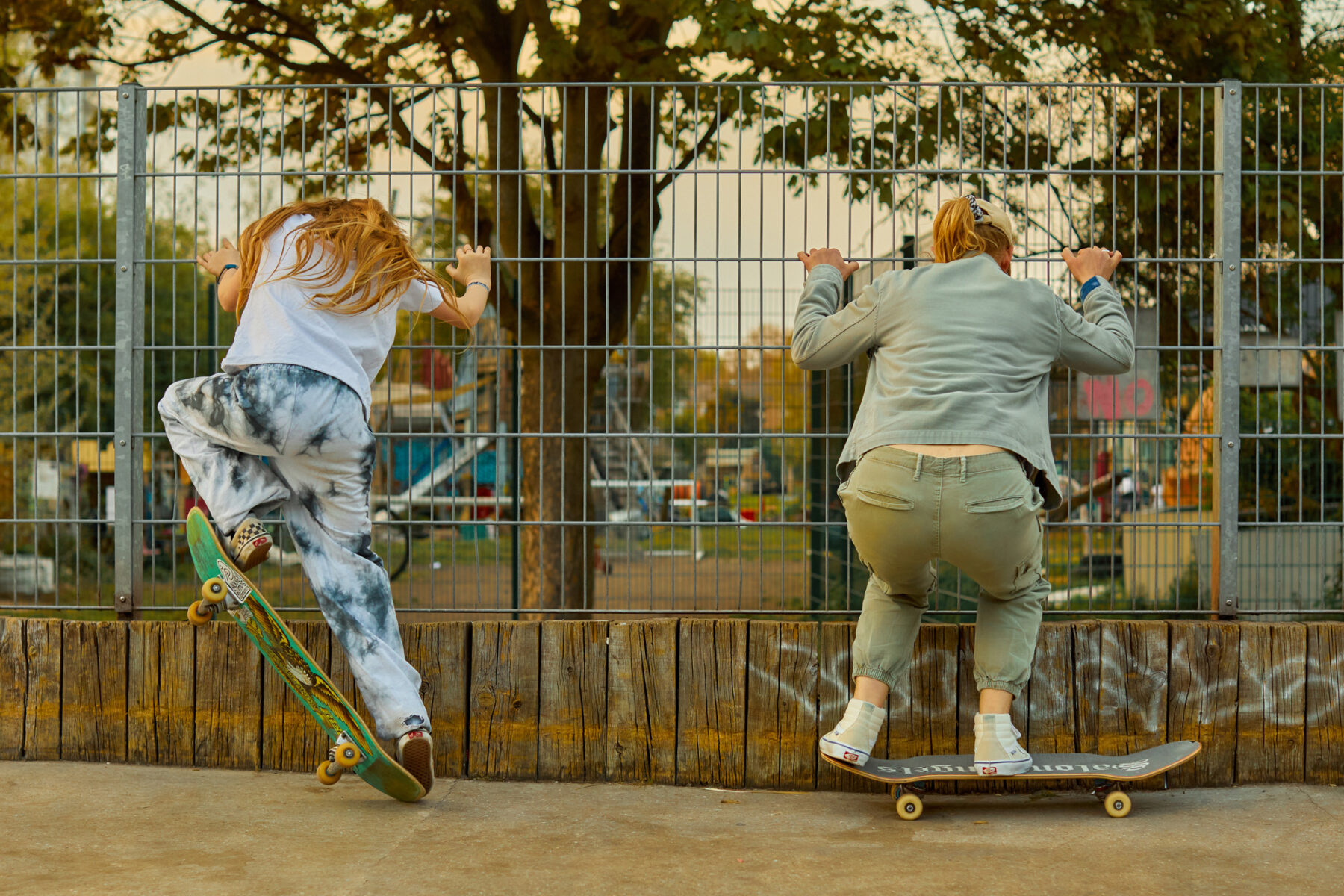
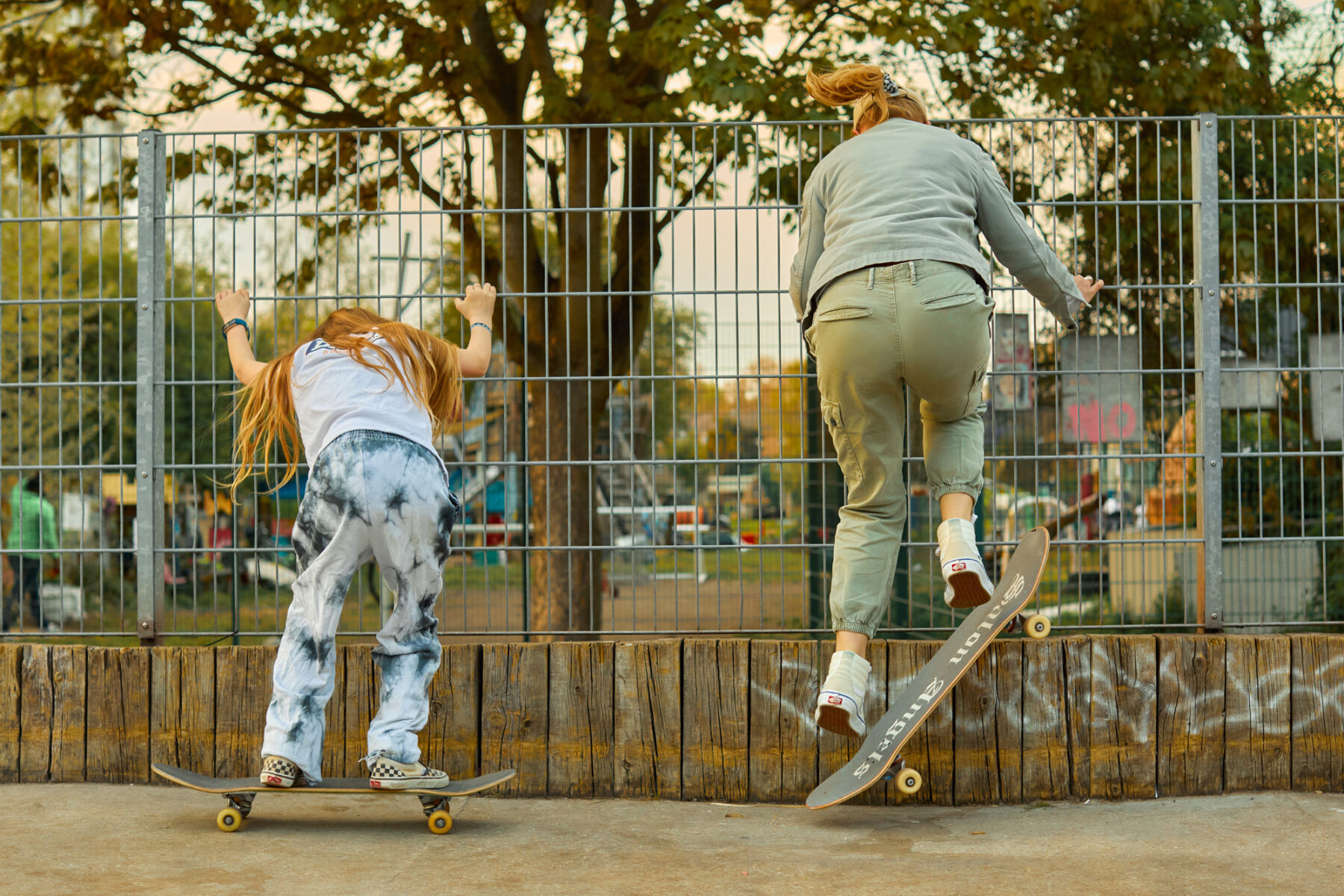
For the teen and pre-teen girls at Hackney Bumps, there is a strength in numbers that insulates them from the judgement of others. When we met up with Danni Gallacher at the Skate Retreat, a skateboarding retreat for women, trans, non-binary skaters and their allies, she talked about how women and girls go into a skatepark thinking it’s not their space and about a societal shift in skateboarding where they are starting to feel “part of the park,” “taking up space” and that’s changing the kind of tricks that they perform there. “If all you have is the little strip down the edge of the park then girls spend more time doing the same sort of tricks at that level,” said Danni. If they take up space in the park, then their skateboarding can evolve.
The visibility created by the Olympics for girls’ skateboarding is powerful and has already had a positive effect, especially through providing a sense that they are entitled to participate too. Girls’ involvement and competence are taken for granted3. Professional skateboarders Mimi Knoop and Cara-Beth Burnside (with lawyer Drew Mearns) worked to ensure that X Games made the prizes for women equal to those awarded to men. If women and girls are not supported equally then it is harder for them to progress. Progression Project Lead for Skateboard GB Lucy Adams said: “It is only now that we’re seeing a conscious effort to include women as a first thought. Take planning a skate event for example, there’s often: ‘Oh shit, we’d better have a girls’ jam – we’ll just put it on at 10am before the men’s practice, as that’s the only space we can allocate.’ Or when the judges are already sorted: ‘Oh shit, should we have a woman judge?’ There are countless other examples. Women and girls have been an afterthought in skateboarding for long enough. Finally now we’re seeing brands, mags, groups and parks dedicate more time and space to them, which is fully deserved.”
Women have skated for as long as men, but the limited visibility of women’s skateboarding has impacted on sponsorship, which in turn impacts on them having the support to progress. To increase the visibility of women and girl skateboarders, they need to be written into the narrative around skateboarding – skate archives should include parts featuring women. But rather than seeking to be included in existing publishing, some skateboarding women have worked to create their own archives. As Aurora said: “There’s never going to be complete equality and maybe you have to accept that and create your own scene.”
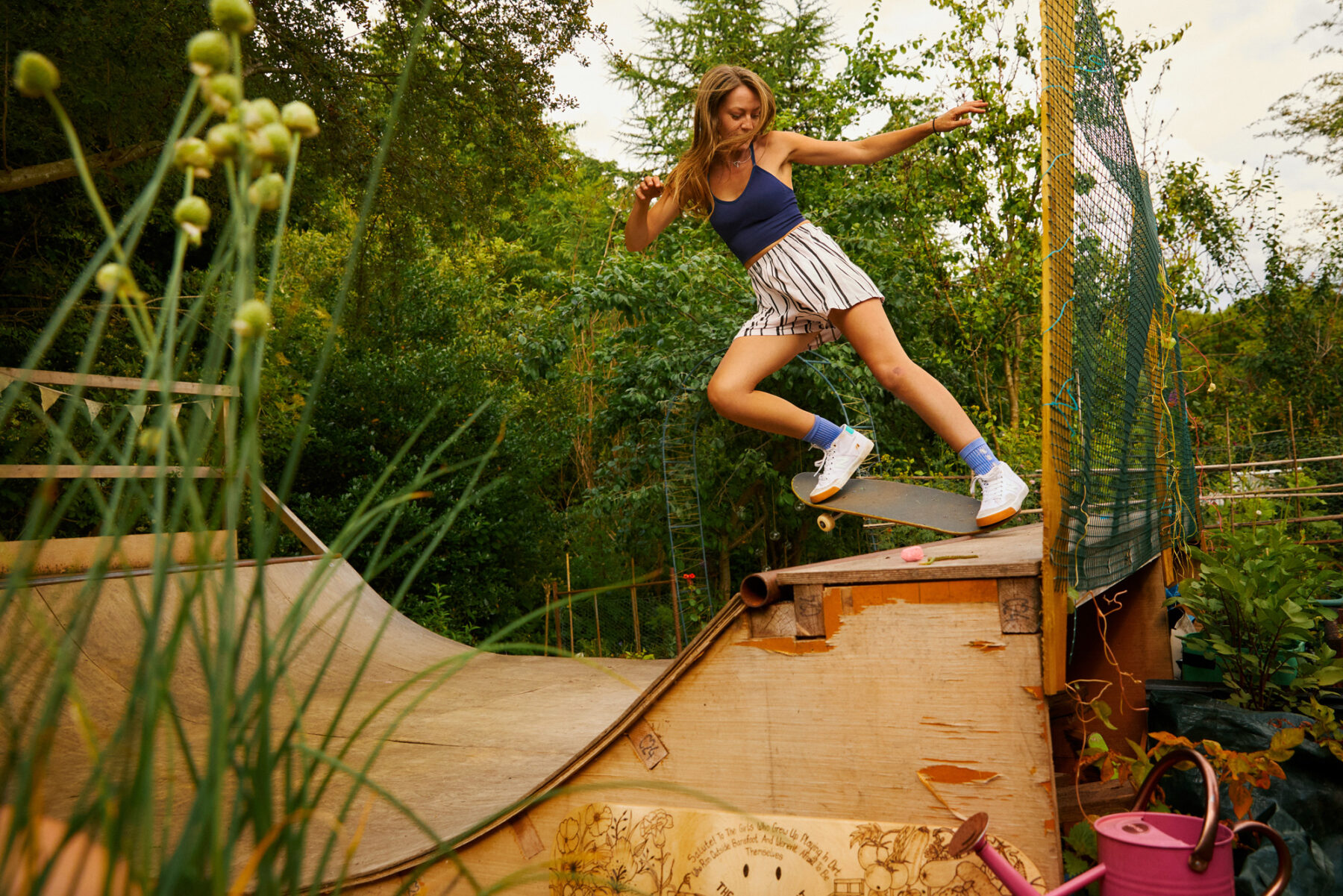
Photographer Charlotte Thomas created a significant archive when she published Concrete Girls in 2018. This book of photographs has played an important role in making the girl skate scene in the UK visible. Filmmaker and photographer Jenna Selby and the international group The Skate Witches have also made exceptionally important contributions to the visibility of women, queer and non-binary skateboarders. Building an archive of imagery that shows the diversity of skaters is essential to represent a historical narrative for skateboarding that reflects the whole scene. In the 2008 chapter ‘Take the Slam and Get Back Up’, Michele K Donnelly makes the point that skateboard media has reinforced ideologies of gender difference, which perpetuates the positioning of women as outsiders in skateboarding culture. Normalising masculinity as a prerequisite to ‘core’ skateboarding can lead to skateboarders experiencing sexism and transphobia online linked to gender normative ideas about ‘proper’ skateboarders4. Photographer Amanda Fordyce said: “A big part of what we wanted to do for this article is show you don’t have to be doing these wild, crazy tricks, it’s still skateboarding.” The focus here is on photographing girls in action to show a quieter communal activity of friendship, mutual support, supporting each other and helping each other out.
During the interview at Stockwell with Helena (Long), Daphne and Aurora, I asked if trying to include everybody in a singular mainstream might be counterproductive. “It becomes tokenism so quickly,” said Helena. “I remember in 2017 / 18… every company just suddenly shit their pants. They were like: ‘We don’t have one [a girl]!’ And then they were jumping to get one, like: ‘Everyone would be really stoked if you were on the team.’ And you’re like: ‘Where did this come from?’ Also, why out of the blue? I’ve been skating for 10 years already. It was like the head of marketing was like: ‘Oh, girls on skateboards, let’s focus on that.’” Aurora added: “You create your own space, you create your own culture instead of trying to feel like you belong in the mainstream culture. You go and create your own thing and talk about the stories you want talk about.”
Skateboarding is not easy; we can support the development of girls’ skateboarding at a time of vastly increased interest by paying attention to the environments in which effective learning happens – to explore the social nature of learning. In our interviews we asked girls how they learn; many have said that learning from friends is their main method.
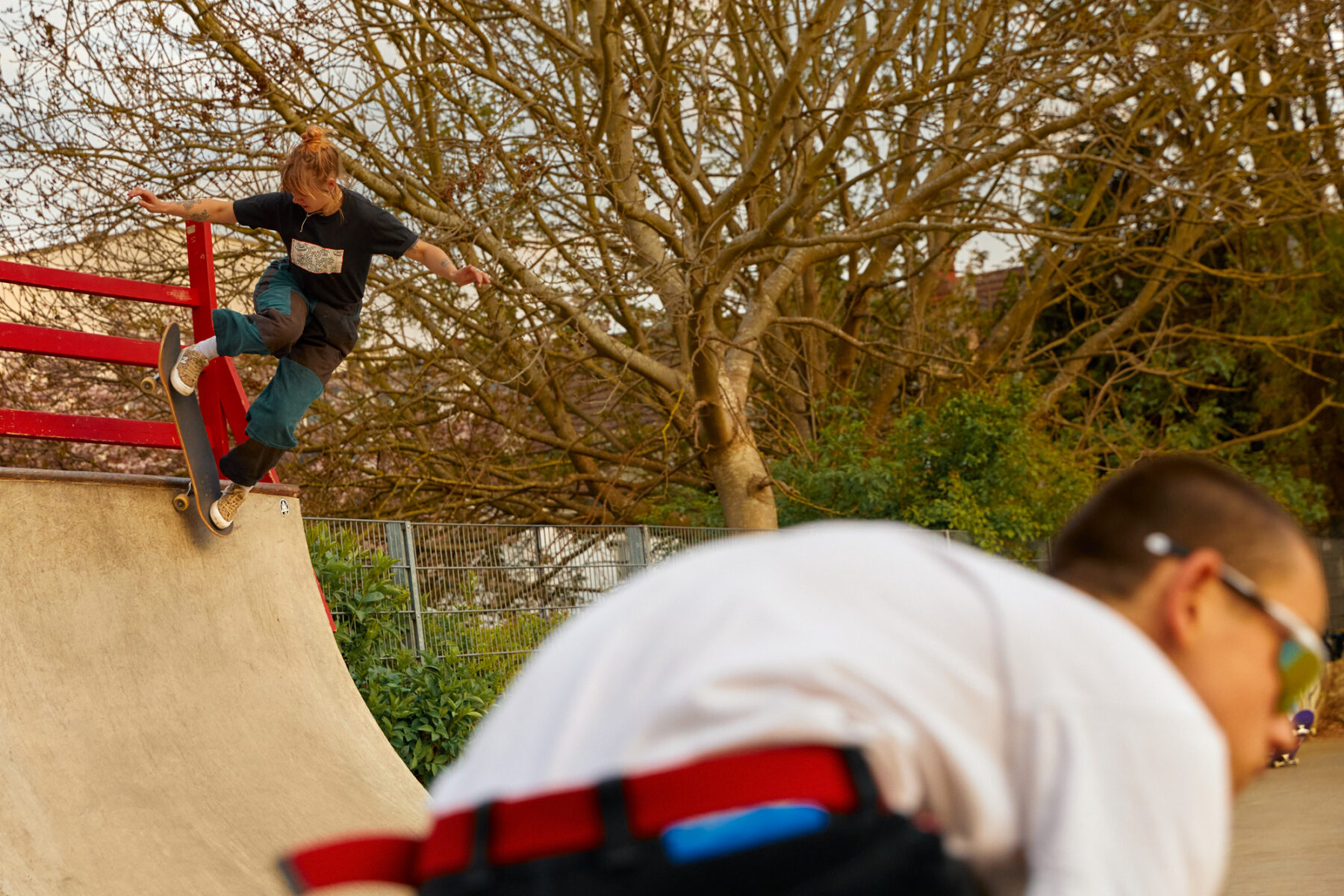
When we talked to the girls at Hackney Bumps, Eva said: “At the very beginning no one knew what to do [laughs]. We used to watch YouTube videos in the park. That’s when we were first trying to ollie, we were just watching videos.” Evie added: “When we all did the drop-in, when we first came to Bumps, we all tried that drop-in and it was the scariest thing. We held hands and did it by helping each other.”
Learning to skateboard is messy, it doesn’t follow a clear structure or set trajectory, it is exploratory, experimental and improvisational and success is measured by the individual and their peers. This contrasts with the way we are educated within constrained and predetermined school curricula – skateboarding requires skaters to manage complexity, contradiction and crisis for themselves. Within any learning, failure is inevitable at some point; without it we wouldn’t learn. Skateboarders know that failure can be useful – it agitates, it incites further action – but critical observation and judgement can negatively affect our ability to progress. Women understand the paradoxical experience of feeling self-conscious because of being watched and judged, while also feeling marginal. This is where the peer-to-peer mechanism that happens in the skatepark is important for effective learning. Friends support one another.
Is a sisterhood at the heart of girls’ skateboarding? Aurora thinks so: “I think women are nicer to each other than the brotherhood of skateboarding.” Amanda explained how the girls in the photographs all come from different friendship groups at school: “Because they all skate together they’ve got this other friendship.” Helena remembers her skateboarding friendship group fondly: “It’s so nice to have friends outside of school, outside of work – your skateboarding friends. I remember loving that at school.”
Images of females in skateboarding who are sitting on the periphery or wearing skate clothing rather than actually skating don’t show girls in action. In the images seen here girls skateboarding is at the centre of the action, in fact the images specifically question what constitutes ‘action.’ The experience of skateboarders is hard graft, occasional successes and above all friendship. This is the everyday experience of skateboarding that is more common than the incredible feats of high stakes, awe inspiring skateboarding that are the bulk of what is shared in skate media.
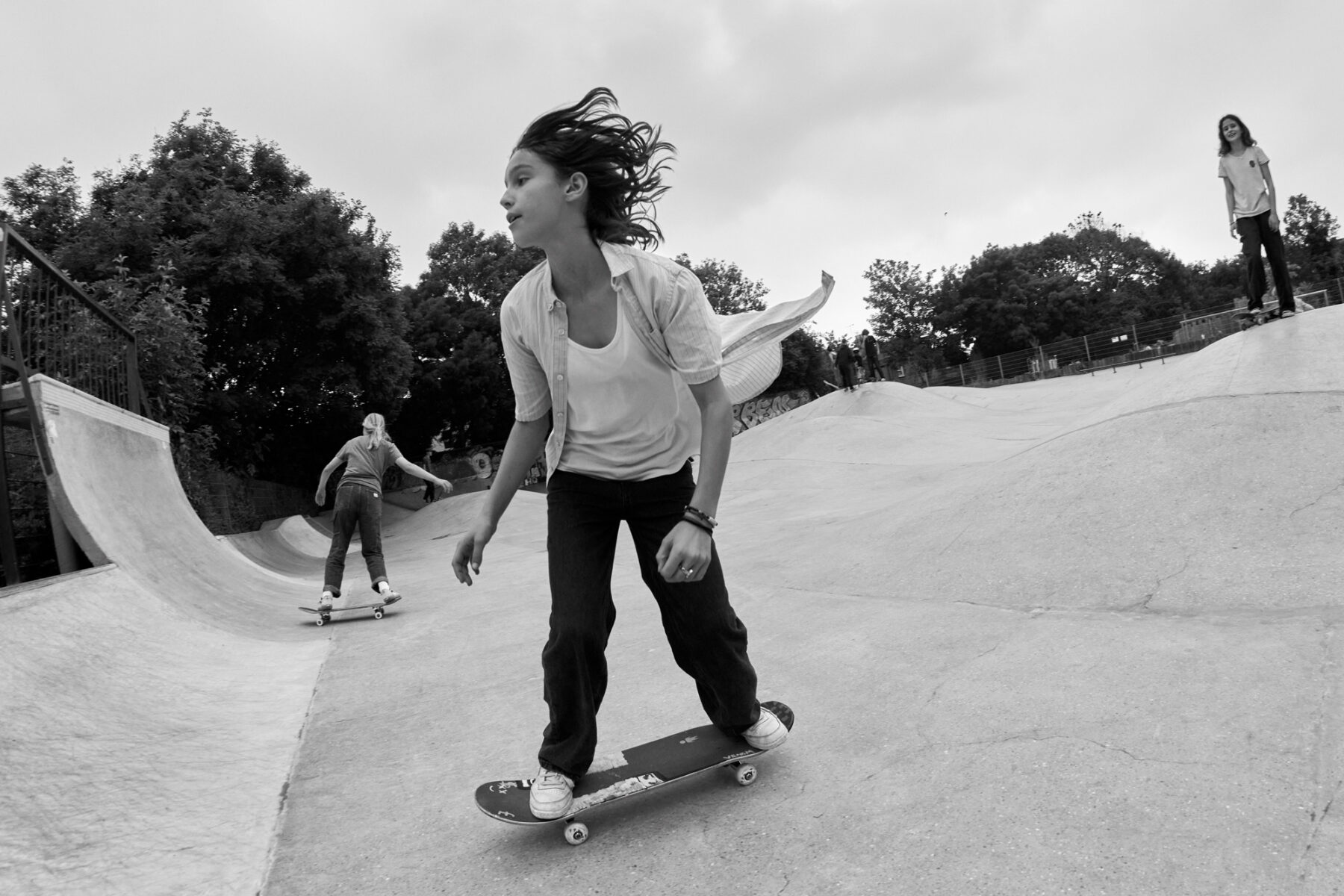
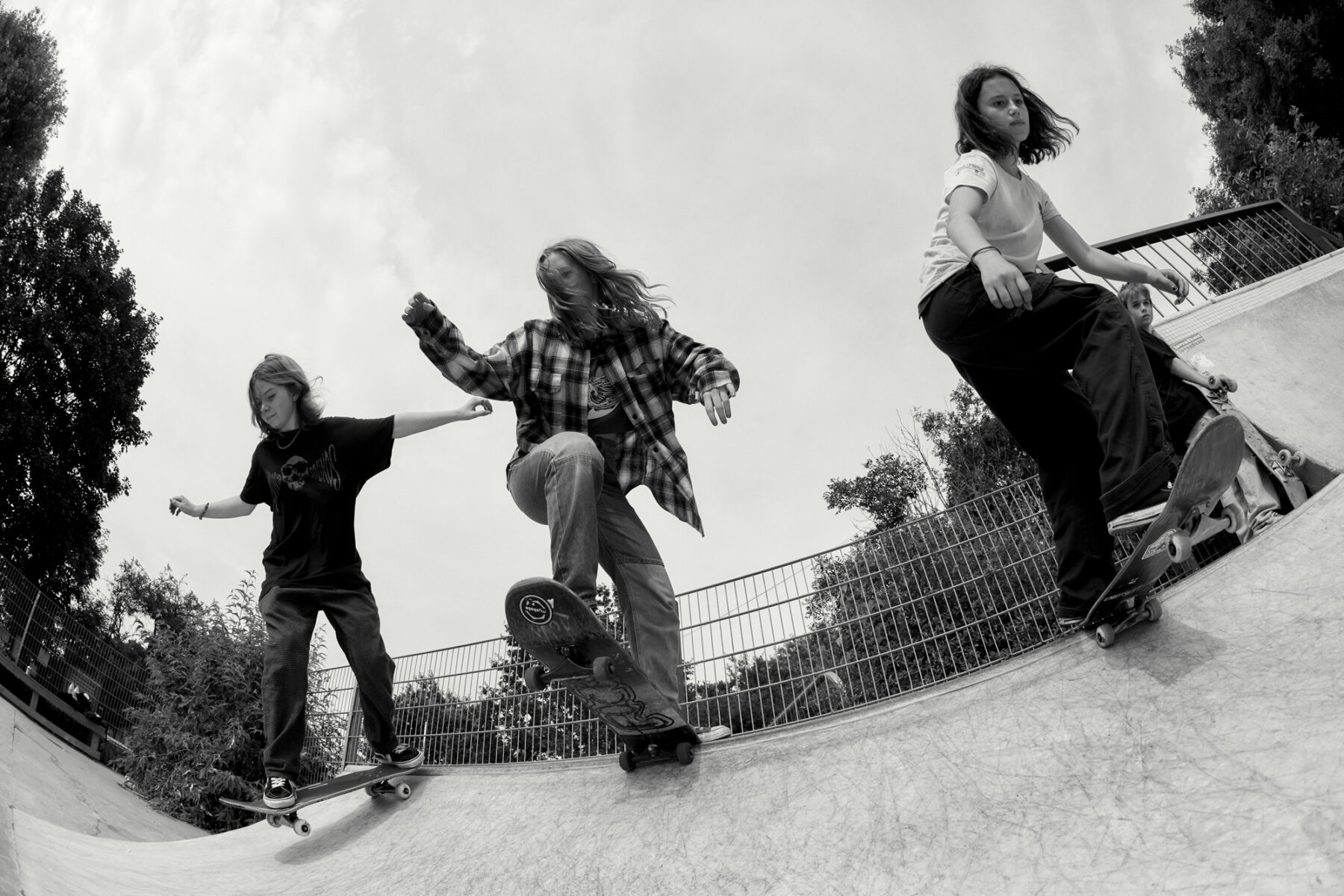
When interviewed, the girls in these images described gaining skills and confidence with the help of their friends. Evie explained: “Some people are better at some things than others because tricks require different things. Like Iris is really great at drop-ins because she’ll just go for anything. She doesn’t care – she’s not worried about being hurt. So she taught us and helped us.” “It’s often a mental block,” added Annie.
They talked in detail about how they learn and how peer support is key to their development. Girlhood here is defined by what their bodies can do, not what they look like or what others think of them. Showing women and girl skateboarders engaged in ‘doing’ rather than ‘performing’ transforms the process of being looked at and objectified into one in which a skateboarder owns her actions and feels them in her body. They talked about constructing their identity around practical considerations with many changing their style of dress since starting skating, adjustments like not wearing tight clothing or skirts to skate in. They did not explicitly describe attempting a kind of androgyny, although the blurring of clearly distinguishable gender performance in girls’ skate clothes is interesting. Some of the girls we interviewed described a rethinking of gender norms and all clearly position themselves firstly and affirmatively as skateboarders rather than by gender affirmation. While practicality is often cited as the reason for androgynous clothing choices, the selection seems to be more cultural than practical.
Eva said: “I feel like I would [wear a dress] if I was roller skating. I don’t know why I feel like the community is different. With skating you feel like you’re gonna be judged if you show up to the skatepark in skinny jeans and tank tops.”
I asked the more established female skateboarders about clothing. Helena said: “I do feel way more comfortable and safer in clothes I can fall [in] and rip. Practically safe, but also safe as in feeling like I’m not singled out. When I started skating, I never thought about being a guy or girl… And that made me safe because I just felt like I was just the same as everyone else.” She went on to describe: “Blending in, which is why all skateboarders look the same, is funny because it is the most attention-seeking thing you could do. Skateboarding is loud, it’s annoying, it’s in your face, like boards everywhere, it’s painful. And then it’s like: ‘I actually want to hide in this corner and just do my thing. So I’ll do that by trying to blend in and look the same as everyone else so that falling over doesn’t look so dramatic.’ It could be a guy falling over and that’s fine, but to be a girl falling over it’s a bit more like… a thing.”
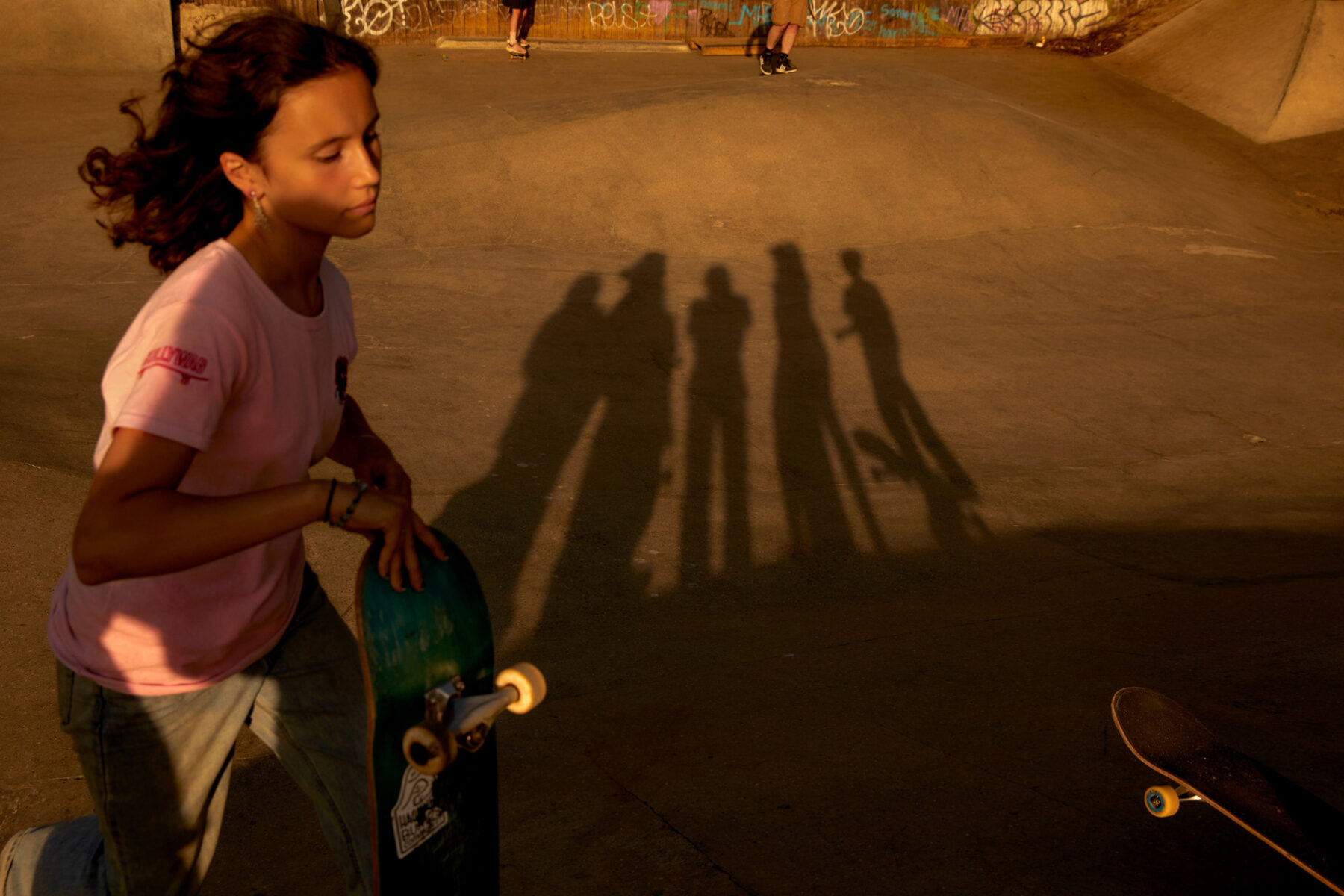
Skateboarder and Salon Skateboards owner Stefani Nurding pushes the boundaries of what clothing is considered appropriate for skateboarding. On this subject, Stef said: “Breaking away from the idea that you had to dress a certain way was so freeing for me. I see fashion the same way I see skateboarding: something to have fun with, experiment with and make mistakes [with]… as a way of communicating and expressing feeling. I wish more people could see it this way.”
Daphne added: “I think we’re seeing more girls in magazines now because you get more women being involved in the industry. I don’t think it’s about [the visibility of] girls specifically. I think it is femininity that’s getting held down – not actual girls – because you get loads of girls, but it’s a different thing when it’s like Stef for example, that’s like super feminine. I’d like to see more of that in skateboard magazines.”
In her (2020) book Skateboarding and Femininity, Dani Abulhawa explores: “The complex and varied nature of skateboarder identities and the ways in which girls and women have held and created space for themselves within sexist and hetero-masculine skateboarder identity narratives and practices.”
Often in physical activities, children participate while adults watch and facilitate. But skateboarding confuses the normal order of things as adults play too. There has been a huge rise in older women taking up skate-boarding during the recent lockdowns. Some of the members of the Gnarly Mums group I spoke to expressed that having the confidence to walk into a skatepark full of men is easier as an older woman, that they’ve become more confident with age. For children, it is normal to learn new skills. For an adult, taking on new things that could cause injury can generate a societal reaction. Society does not accept risk-taking in older people as readily as in those who are younger. Women are nurtured to be caregivers and because of this – for mums in particular – placing oneself at risk can be freeing.
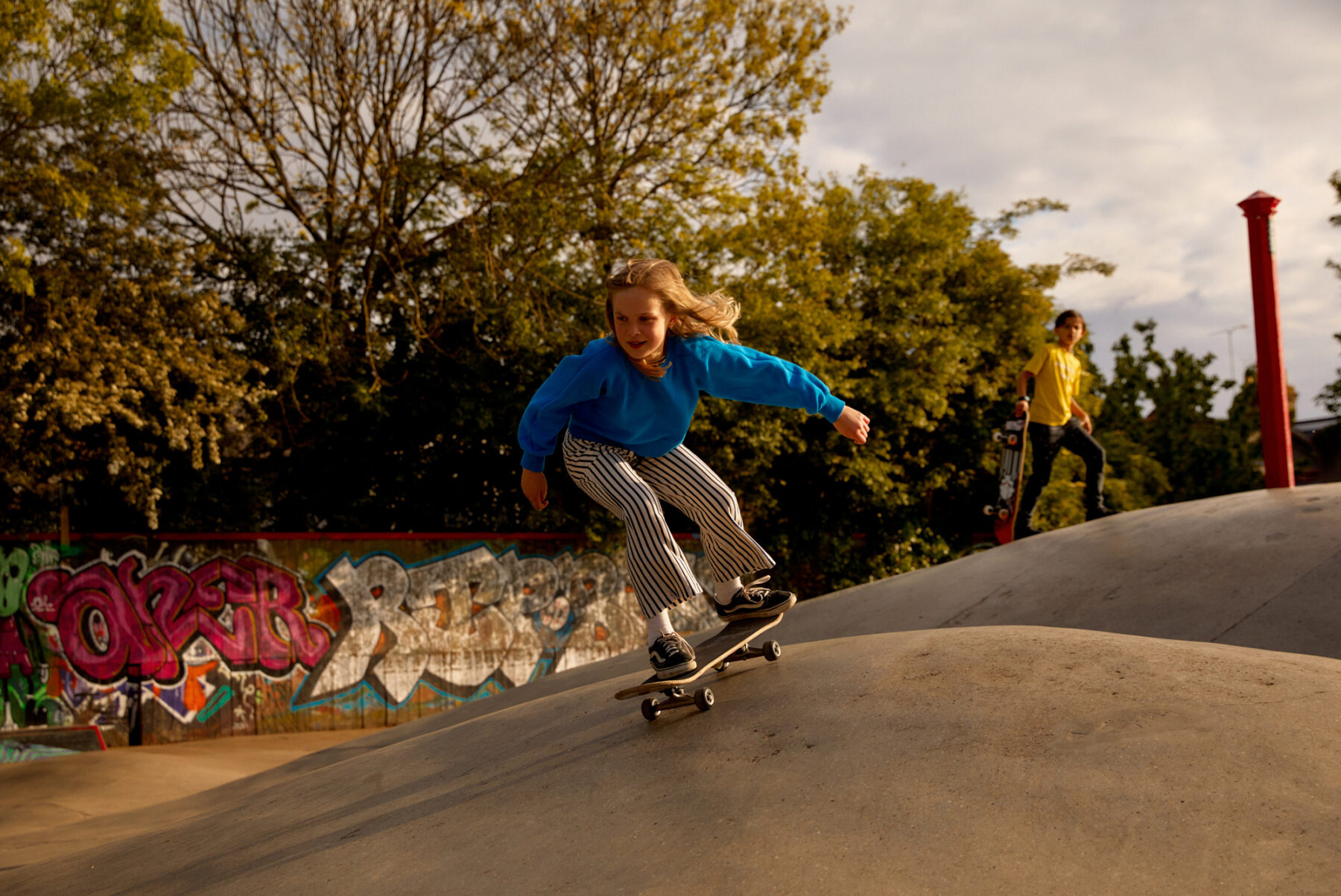
Girls’ nights are important as they provide an environment for communal learning that is different to a jam, which is more about competition and prizes for best trick. Aurora described the huge impact of her first girls’ night: “The girls’ night where I met Helena was revolutionary. I’d been skating at a curb by myself, and I walked into Bay 66 and there were 20 girls, and they were skating and Helena was there – wearing hoop earrings – and I was blown away like: ‘Oh my god, I’m not the only one!’” Helena’s first experience was also memorable: “I had the exact same reaction when I first saw that number of girls in one room. It just happened that at that time that was the whole country [of girl skateboarders]. Going to the girls’ nights I was surprised at how many there were, which was really cool. It’s hard to explain because I happily skate with guys, girls, whoever, but there was something like an underlying, extra additional connection for the fact that you are surrounded by other female skaters. And I do really enjoy that and feed off it in a different way… I don’t think it’s a bad thing at all as it is a safe space for those that don’t maybe have that confidence.”
The Girl Skate UK Connect campaign is about the social nature of skateboarding, that sense of community and connecting girl skate groups, building a community, empowering girls to do it for themselves. Danni, founder of Girl Skate UK, explained: “There wasn’t a specific place where people could find all the girls’ groups in the UK. I wanted to localise it in other cities, to make it easy for girls to meet up, make new friends and get events going. In the end, we probably got 50 or 60 brand new girl skate groups linked up.”
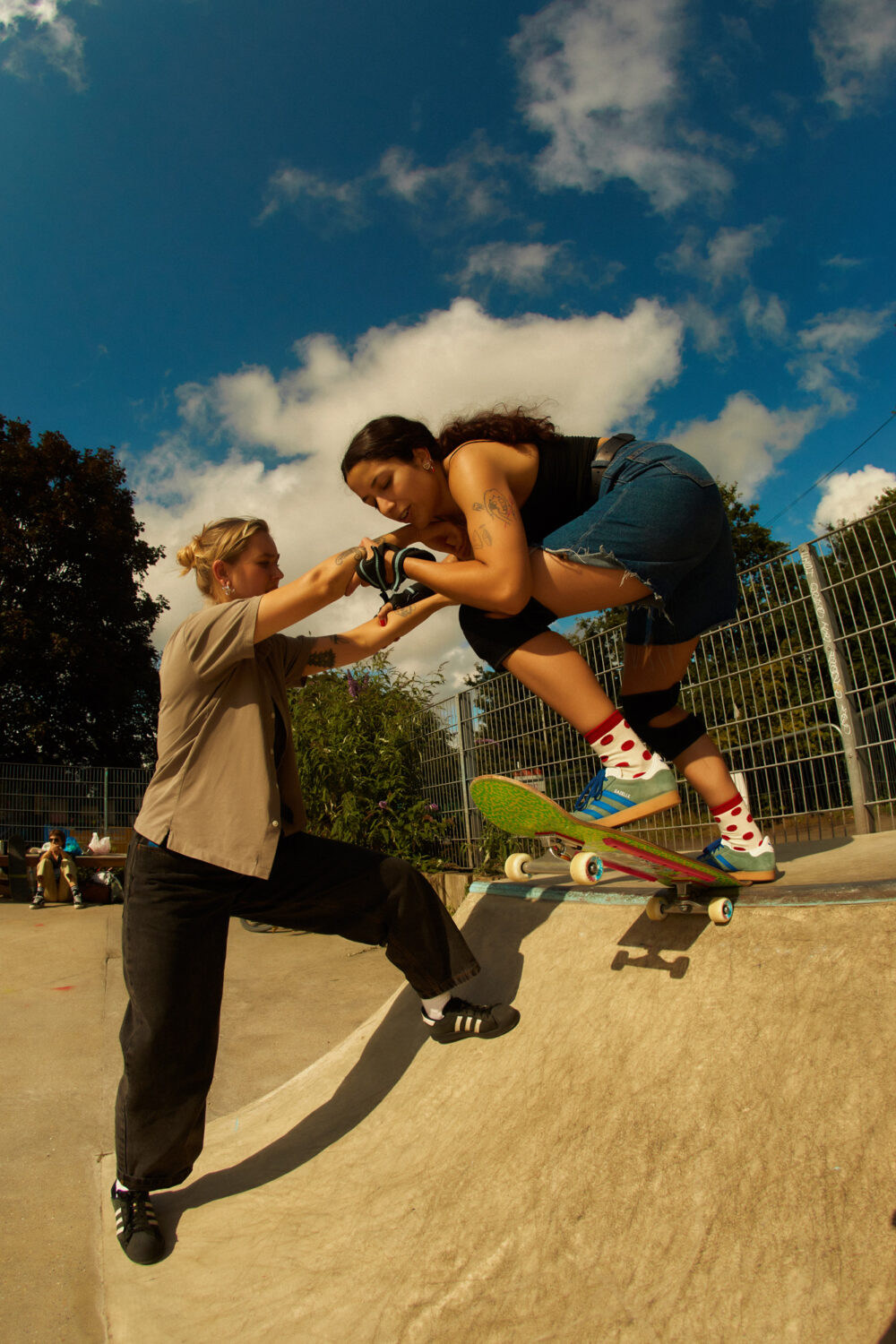
Girls’ jams have traditionally been where lessons have taken place. But outside of girls’ nights, demand for learning run by women and non-binary teachers has been growing exponentially over the past few years. Here skateboarders – usually self-taught – who share a commitment to supporting others have been putting innovative approaches into practice. At the Skate Retreat and in the Keep Pushing project, enormous care is taken to generate new approaches to supporting skate learning by developing teaching methods that attend to the physical and the psychological aspects of skateboarding. Here the individual, their body, their mind, and the environment in which learning takes place are all given equal consideration.
Alongside the developments in learning to skateboard it is fantastic to see so many girls’ groups forming, and women-run skate businesses like Brixton’s Baddest, Salon and Doyenne Skateboards continuing the work that Rogue Skateboards was doing in the mid-2000s.
At its best the skateboarding community displays a strong built-in inclusivity, not as a tokenistic political gesture but as a strong, caring ethos. In contrast to this skateboarding is unapologetically exclusive – because you must do it to be part of it. The logic of continually asking: “who is not visible?” and working hard to make sure those people are seen and listened to can ensure that the opportunity to participate is open to everyone.
Dr Esther Sayers is an academic, skateboarder and mother of three children.
Check our more photos by Amanda from the project below. You can watch Deimante Sprainaityte‘s accompanying film Skate Sisterhood here.
1 In their 2005 article ‘Skater girlhood and emphasized femininity: ‘you can’t land an ollie properly in heels’’, Kelly, Pomerantz and Currie use the term ‘skater girlhood’ to describe specific values that adolescent
girls experience as skaters, like being different, braver and stronger than their experience of girlhood as non-skateboarders.
2 In Judith Butler’s 2006 book ‘Gender Trouble’ she addresses the outward displays of gender as performed rather than innate. She makes the point that we are nurtured into certain characteristics of gender rather than possessing naturalised girl or boy identities.
3 In their 2018 article, ‘Skateboarding beyond the limits of gender? Strategic interventions in Sweden’, Bäckström and Nairn suggest interventions that aim to assist young women to enjoy gender equality in skateboarding.
4 In her 2015 chapter ‘Spreading the Skirtboarder stoke: reflexively blogging fluid femininities and constructing new female skateboarding identities’, MacKay explores the marginalisation of female skateboarders in mainstream media.
